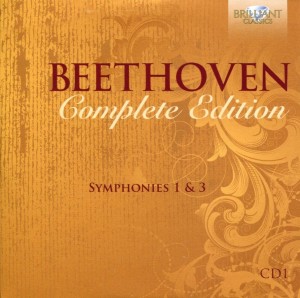 The premiere of Beethoven’s Symphony No. 1 took place on 2 April 1800.
The premiere of Beethoven’s Symphony No. 1 took place on 2 April 1800.
Beethoven was 30 years old.
According to its entry on Wikipedia,
Symphony No. 1 in C major, Op. 21, was dedicated to Baron Gottfried van Swieten, an early patron of the composer. The piece was published in 1801 by Hoffmeister & Kühnel of Leipzig. It is unknown exactly when Beethoven finished writing this work, but sketches of the finale were found from 1795.
The symphony is clearly indebted to Beethoven’s predecessors, particularly his teacher Joseph Haydn as well as Wolfgang Amadeus Mozart, but nonetheless has characteristics that mark it uniquely as Beethoven’s work, notably the frequent use of sforzandi and the prominent, more independent use of wind instruments. Sketches for the finale are found among the exercises Beethoven wrote while studying counterpoint under Johann Georg Albrechtsberger in the spring of 1797.
The beginning of the twelve-bar introduction of the first movement is sometimes considered a “musical joke”. For example, the English musicologist Donald Tovey has called this work “a comedy of manners”. In fact, Symphony No. 1 can be regarded as a result of Beethoven’s bold musical experimentation and advancement which he presents five years after Haydn’s last symphony and twelve years after Mozart’s final Jupiter Symphony.
Fascinating. I had no idea Beethoven was so heavily influenced by Haydn and Mozart.
I can tell from the first few bars of Symphony No. 1 that this is a very mature composition, quite solid, and absolutely listenable. In fact, the Wiki entry for Beethoven’s Symphony No. 1 concludes with this:
The musical form is in accordance with the established composing tradition. Musical content, instrumentation as well as tempi, is unusual—if not revolutionary—in its use for a symphonic work of Beethoven’s time. Therefore, Beethoven introduced himself with this work uniquely and boldly as an advancing symphonic composer and stood true to this statement throughout his compositional life.
I can hear that. This is a bold piece of music. I immediately liked it better than much of what I heard from Haydn. It has more melody. And depth. And dynamics.
Speaking of which, I learned a new word this morning: Sforzando.
According to the entry on Wikipedia for Dynamics,
Sudden changes in dynamics may be notated by adding the word subito (Italian for suddenly) as a prefix or suffix to the new dynamic notation. Accented notes (notes to emphasize or play louder compared to surrounding notes) can be notated sforzando, sforzato, forzando or forzato (abbreviated sfz or fz) (“forcing” or “forced”). One particularly noteworthy use of forzando is in the second movement of Joseph Haydn’s Surprise Symphony.
Accents can also be notated using the sign >, placed above or below the head of the note. The > sign indicates an accent only, and is neither related to nor derived from the sign for diminuendo, even though the signs are of a roughly similar shape.
Sforzando (sfz) notationSforzando (or sforzato or forzando or forzato), indicates a forceful accent and is abbreviated as sf, sfz or fz. There is often confusion surrounding these markings and whether or not there is any difference in the degree of accent. However all of these indicate the same expression, depending on the dynamic level, and the extent of the Sforzando is determined purely by the performer.
Symphony No. 1 in C Op. 21 consists of four movements:
I. Adagio Molto – Allegro con brio
II. Andante cantabile con moto
III. Menuetto & Trio: Allegro molto e vivace
IV. Finale: Adagio – Allegro molto e vivace
Symphony No. 3 in E Flat Op. 55 “Eroica” also consists of four movements:
I. Allegro con brio
II. Marcia funebre: Adagio assai
III. Scherzo & Trio: Allegro vivace
IV: Allegro molto – Poco andante – Presto
According to its entry on Wikipedia,
Symphony No. 3 in E-flat major, Op. 55, also known as the Eroica (Italian for “heroic”), is a musical work marking the full arrival of the composer’s “middle-period,” a series of unprecedented large scale works of emotional depth and structural rigor.
The symphony is widely regarded as a mature expression of the classical style of the late eighteenth century that also exhibits defining features of the romantic style that would hold sway in the nineteenth century. The Third was begun immediately after the Second, completed in August 1804, and first performed 7 April 1805.
Beethoven was 34 when this was completed and 35 when it was first performed. (Just to put things in perspective, Mozart was already dead. Haydn would die in another couple of years.)
Staatskapeele Dresden performs the music on this CD, with Herbert Blomstedt (1927- ) conducting.
The recording is rich and resonant, crystal clear without being tinny.
These two symphonies surprised me. I had no idea Beethoven was this enjoyable.
